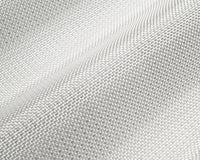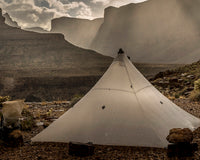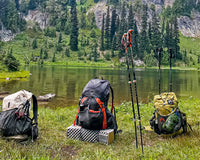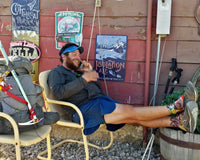
Photo by Dan Ransom
Hyperlite Mountain Gear Founder Mike St. Pierre has structured his entire life around his three passions: music, food and the outdoors.
“I toured with a lot of bands, but primarily the Eagles,” he said of his career in music. He then shifted his focus to food, spending three years working in the best restaurants in New York City and Washington D.C.
“Working at Michelin Star restaurants is very stressful,” Mike said. “My stress relief was to get out into the backcountry as much as possible.”
On those trips, Mike found himself wanting to go deeper and farther, but was limited by the weight and bulk of his gear. The backpacking packs on the market at the time had “20 pockets, six zippers and got heavier when wet,” Mike said. Mike eventually ended up ditching those packs in favor of kids’ book bags.
But then something happened that changed Mike’s trajectory: he found Dyneema, which at the time, back in 2010, was called Cuben Fiber — a fabric that originated in the sailing industry.
Mike started building pack prototypes out of Dyneema, and giving them to anyone willing to take one on their adventures.

Photo by Mike St. Pierre
Fast forward nine years. In that time, Hyperlite Mountain Gear has distinguished itself through its modern, minimalist designs. The brand’s packs, shelters and accessories have more than just a sleek look, the Dyneema fabric out of which they’re made means Hyperlite’s gear is also inherently lightweight, durable and waterproof.
“That’s our goal. We haven’t really strayed from that,” Mike said.
While it’s fairly common for people to think about the weight and durability of their packs, Mike said people are less likely to search for a specifically waterproof pack, or to distinguish between truly waterproof fabric — as is the case with Dyneema — and fabric that’s been treated with some sort of waterproof coating.

Photo by Matt Morelli
However, that Dyneema fabric doesn’t come cheap. Mike said it can cost up to 10 times as much as fabric used by other outdoor gear manufacturers. “We’re not selling gimmicky products,” Mike said. “I know that they’re a little more costly than what people are used to, but there’s a reason for that.”
While the use of Dyneema is a big reason for the premium pricing for Hyperlite products, quality design and manufacturing in the U.S. also play a role.
“I would not want to be designing products that are a rung or two down from what’s needed for big activities,” Mike said. “If it’s good enough to climb Mount Everest with, it’s good enough to walk the AT with or go bag a peak in Colorado.”

Photo by Jamie Walter

Photo by Steve Fassbinder
But before heading out with people on their adventures, Hyperlite gear starts out as raw fabric that needs to be cut and sewn.
“If you were to walk through the doors of Hyperlite, you would just see a buzz of activity,” Mike said. Hyperlite occupies two stories of what was once an abandoned cotton mill in Biddeford, Maine. Offices are upstairs with production downstairs. The production floor is filled with the hum of an automated cutting machine that runs 15 hours each day and the murmur of dozens of people behind sewing machines.
“People take a lot of pride in their work,” Mike said. “They understand they can’t make a mistake because that could be a life or death situation for someone on an eight thousand meter peak.”

Photo by Matt Morelli
Mike adds, “It’s a very diverse work group. We have people from all over the world, literally. That’s exciting to see that everyday, especially in Maine where we maybe don’t have the most diversity, so it’s really cool to see that happening within the walls of the business.”
This year, Hyperlite put a lot of effort toward building out its core pack line, releasing both the Junction Pack and the NorthRim Pack. In the coming months Mike said the brand is “looking to expand the offering in some of the other activities we’ve been playing in,” without divulging too many further details around what exactly that means.
The Junction Pack, like many Hyperlite products, was developed because of customer requests. “It’s one thing to design a product in a vacuum,” Mike said. “It’s another thing to really listen to our customers and take that feedback into consideration.”

Photo by Matt Morelli
And it’s also customers who have been in large part responsible for Hyperlite’s rapid growth. “I find there’s a bit of a cult following, which we’re hugely thankful for,” Mike said. "People are proud to wear these products and talk about these products.”
The other crew Mike is quick to give credit to is Hyperlite’s employees: “They’re the ones doing the heavy lifting. We give them the tools they need. But they’re the ones out there hitting the pavement,” he said.

Photo by Steve Fassbinder
With a 10-year anniversary on the horizon and a lot of movin’ and shakin’ internally, all signs point NoBo for Hyperlite. “If we have good products and good marketing, then it all comes together,” Mike said.















